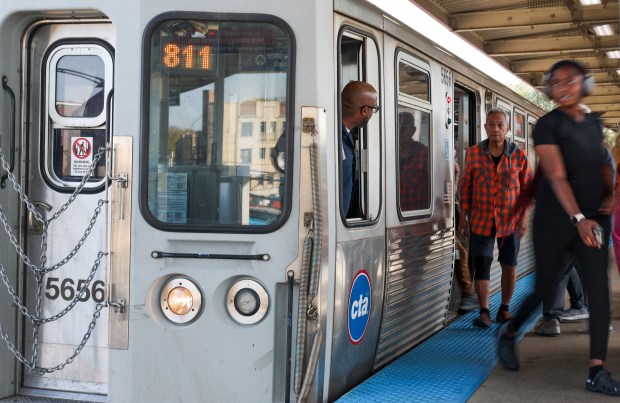The Orange Line operator was directed to take the train out of service because of an issue elsewhere in the system, and was emptying the railcars of passengers. But that Friday morning in mid-October, one customer refused to get off.
With fists raised, the customer got in the operator’s face, the operator’s union President Pennie McCoach recounted. Another passenger came to help, but once outside the train, the person who had refused to leave pushed the operator, who fell to the platform, McCoach said.
The Orange Line shoving was one of several attacks against train or bus operators in recent months. In early September, a CTA employee was injured in a drive-by shooting outside the Howard station in Rogers Park, Chicago police said. In late October, an instructor training a bus operator was involved in an argument with a woman on a bus, and the woman hit the instructor several times, then pulled the instructor off the bus while continuing to hit her, according to police and the bus employees’ union president.
The recent violence is a snapshot of an issue that has long been a concern for the unions representing train and bus operators in Chicago. It is part of a nationwide, decades-long uptick in attacks on transit workers, one researcher found, with implications for transit employees, riders and the systems themselves.
“Transit workers are not just in the wrong place at the wrong time,” said Lindiwe Rennert, a researcher at the Urban Institute who has studied violence against transit employees. “They’re not just another member of the public who’s in a potentially dangerous public space. They’re representatives of institutions. It is because of their role that they are seeing less safe conditions than other members of the public.”
In 2023, there were 90 major assaults on CTA workers: 52 on bus employees and 38 on rail workers, federal data shows. Across both bus and rail, it was the highest number of major attacks on employees since at least 2008, the data shows.
Complete data isn’t yet available for 2024, but through June there had been 13 attacks on rail workers and 26 on bus workers.
The data only captures major assaults, such as those leading to death or requiring transport to the hospital. It doesn’t include more minor events, like the arguments between passengers and bus drivers that bus employee union President Keith Hill described as a common occurrence.
The 2023 uptick in attacks on operators came even as the violent crime rate on the “L” that year — the likelihood of becoming a victim of a crime like a robbery or more aggressive assault or battery — dropped from the highs seen in the early days of the pandemic, but remained stubbornly above pre-pandemic levels.
Assaults on transit workers nationwide have also risen, but Chicago had the second-highest number of attacks that year, Rennert said. That is expected, because the CTA is among the nation’s largest transit systems.
But safety concerns among transit staff can heighten employees’ dissatisfaction, leading to retention problems or even the threat of a work stoppage or strike that can halt a city’s buses or trains, Rennert said. The perception that service is falling apart can also hurt efforts to get more state funding for transit, a key concern for Chicago-area transportation agencies as the end of federal COVID-19 relief dollars looms.
In research published last year, Rennert found a relationship between increasing income inequality and increasing attacks on transit workers.
“Until we deal with that, income inequality in particular, I would not expect to see the improvement that we want to see,” she said.
But there are other factors that can help limit attacks on transit workers in the meantime, she said. Indeed, the number of attacks at a handful of other agencies went down in 2023, Rennert said, such as at Muni in San Francisco, Metro Transit in the Twin Cities and the Maryland Transit Administration, which operates both regional transportation and transit in the Baltimore area.
More frequent and reliable service means passengers have one less reason to get frustrated and potentially take out anger on operators, she said. Clean spaces can help riders feel more valued and heard.
Complaints about service and cleanliness have been among the key issues the CTA has faced in recent years.
“Improved service is, in fact, a safety policy,” Rennert said.
In a statement, CTA officials noted that among recent incidents, an arrest was made in the Orange Line shoving “within several days,” and Chicago police said a 32-year-old man was charged with aggravated battery to a transit employee, a felony. The CTA employee at Howard was a bystander and was not targeted in the shooting, CTA said.
CTA officials sought to direct responsibility for safety to Chicago police, who patrol the system at no cost to the agency. The CTA also pays for additional volunteer off-duty officers, unarmed guards and dog teams.
“The initial responsibility for safety and security of our customers and employees, just as it is with residents of the entire city, is with the Chicago Police Department,” CTA officials said.
Agency officials also highlighted in-house measures to improve operator safety like thousands of cameras in use on trains and in stations, securing customer service assistants’ kiosks at train stations with locks and adding monitors, and a pilot program that uses artificial intelligence to detect firearms once they’re brandished.
Buses have silent alarms that, when pressed, send alerts to CTA’s control center. The agency has also upgraded protective shields around bus drivers and improved communication technology with the dispatch department, the CTA said.
CTA also has de-escalation training for staff, though Hill, the head of the bus employees’ union, said in some cases following the outlined procedures seems only to further agitate passengers.
“All these incidents are unacceptable, and CTA is proactively and collaboratively seeking out additional measures to enhance employee security and safety,” the agency’s statement said.
But McCoach and Hill said more should be done.
McCoach is pushing for a designated transit police force, which she believes would be quicker to take action against perpetrators of attacks.
“If that can happen, I think the employees will feel much safer as well as the customers, the riding public,” she said.
Hill, too, called for a dedicated police force. He pointed to Metra, which has its own police officers, and suggested expanding the commuter rail agency’s resources to cover not just Metra but also the CTA and Pace suburban bus service.
At a recent board meeting, Chief Safety and Security Officer Nancy-Ellen Zusman said the CTA was exploring “all options,” including the cost and length of time it would take to create an agency police force. CTA officials, in their statement, said it would take several years and “a significant financial commitment.”
In the meantime, Hill called for other measures, such as expanding shields for drivers on buses so customers can’t reach around them and improving the reliability of communication with the CTA control center if there’s a problem.
Collecting rider fares can be a key source of tension, he said. He tells bus drivers to use their best judgment with customers who have the potential to be volatile.
“Our goal is to go home the way they came, without being insulted,” he said. “You have to tell the operator to use their best judgment.”





